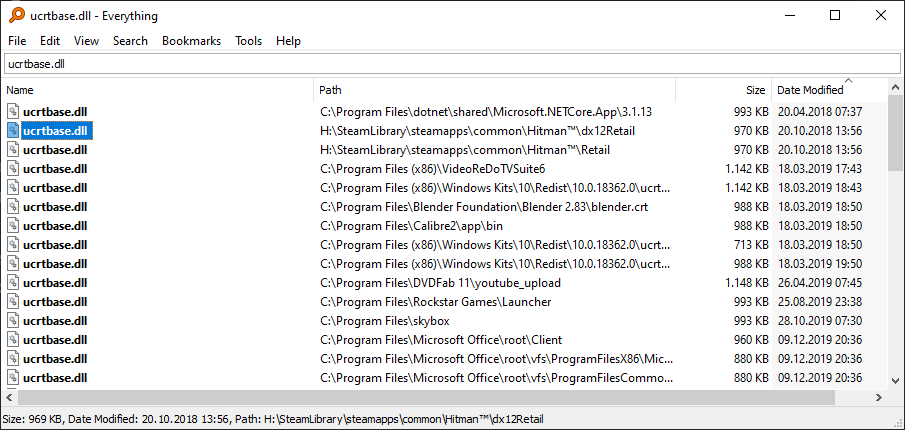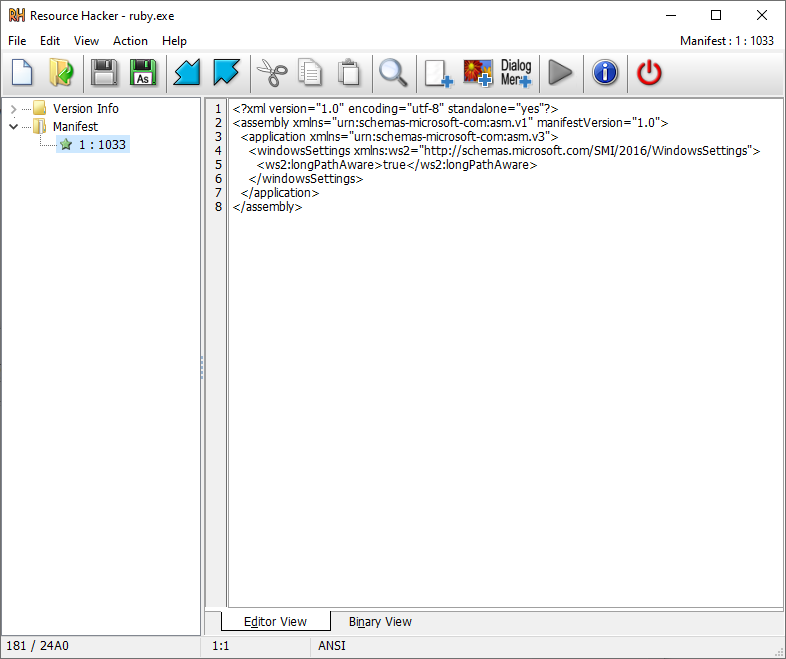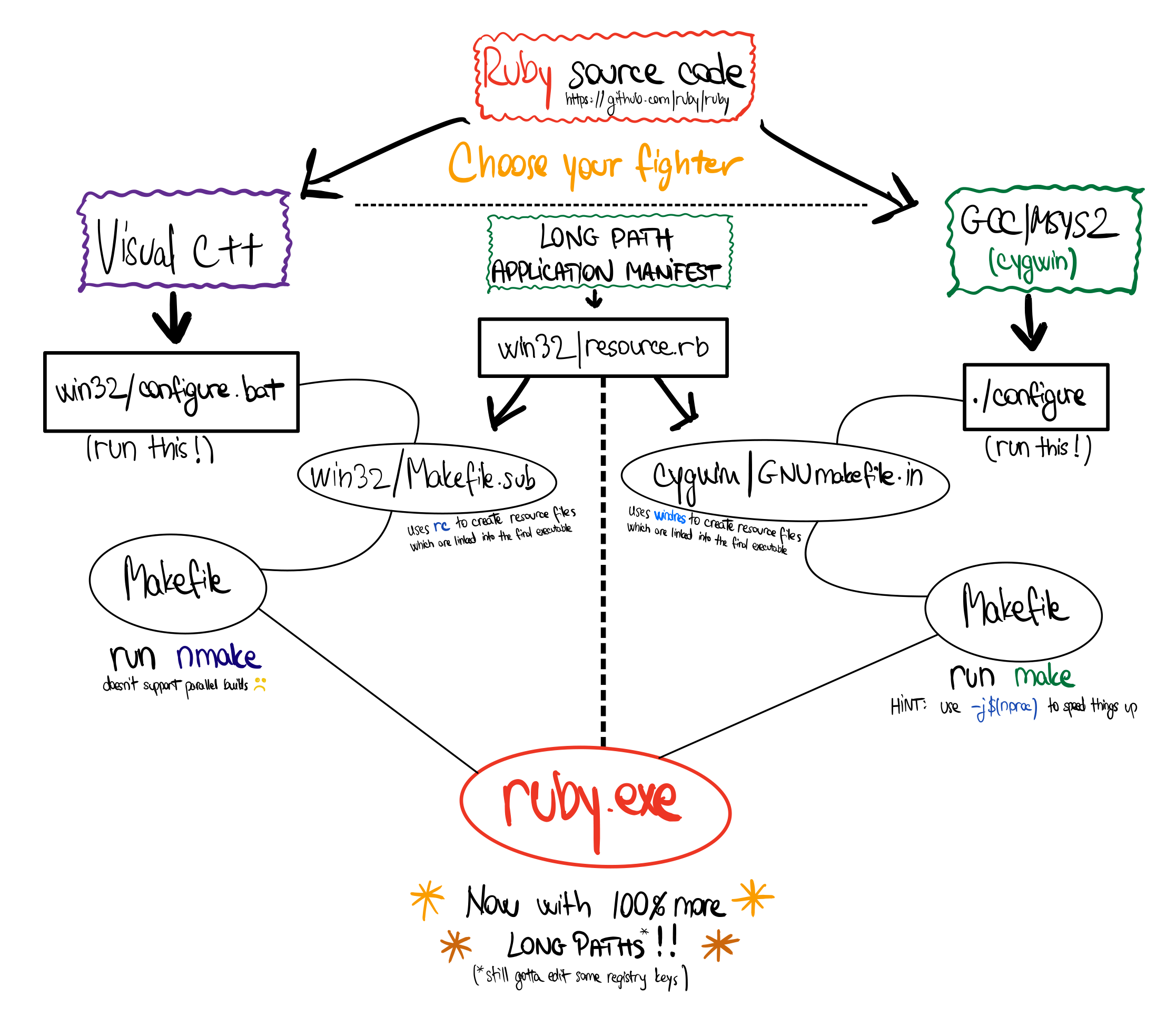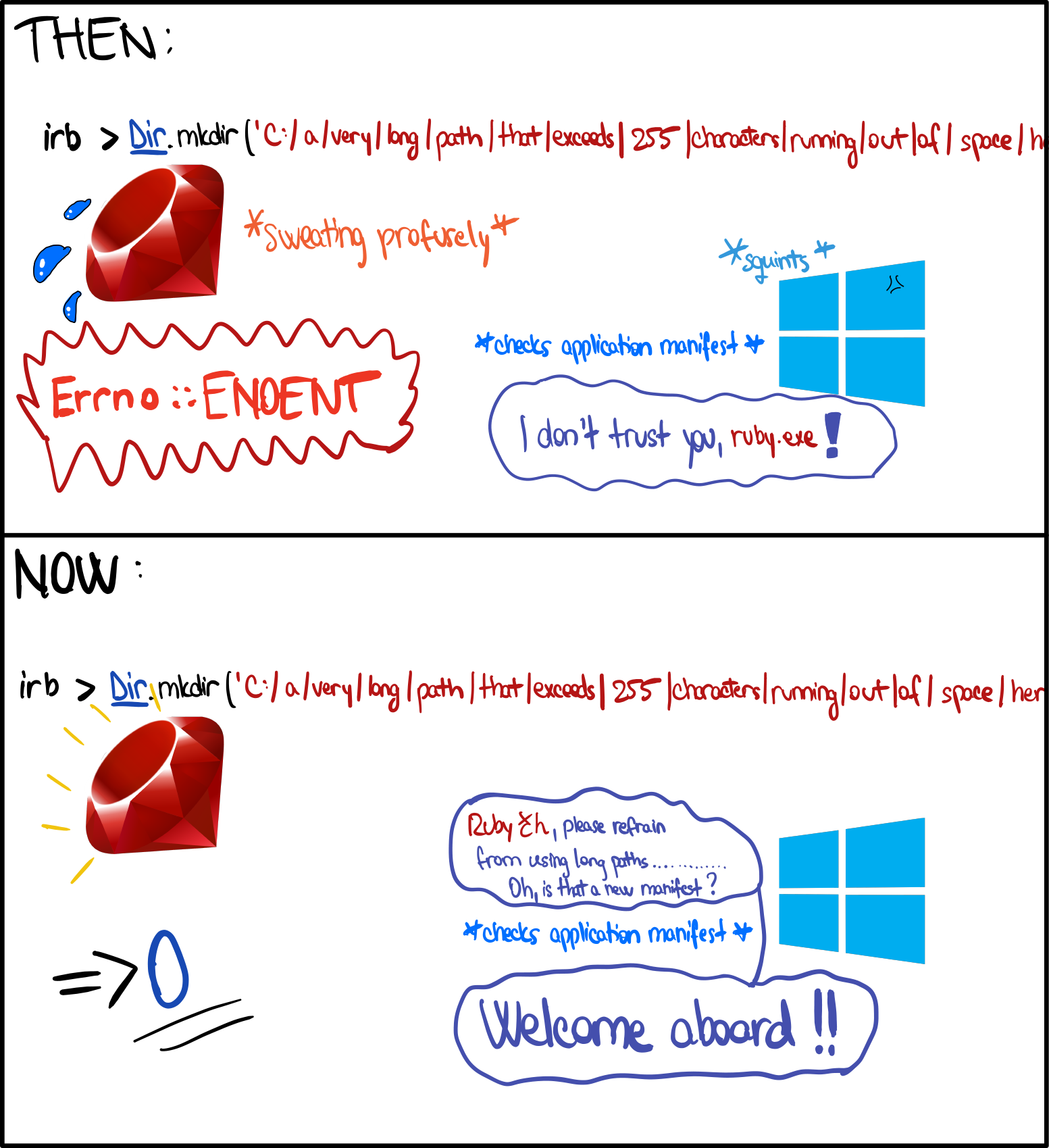Windows, Ruby and Long Paths
Over the past few months, we’ve had a long-standing issue related to Puppet on Windows resurface (puppetlabs/Puppet.Dsc#144). More specifically, Puppet modules with long file paths could not be installed on Windows due to a limitation in the Windows operating system. In short, if a file path surpasses 260 characters, it’s open season: the path has to be referred to in a different format, first-party apps like Notepad or File Explorer start to behave erratically, and there’s no guarantee what works and what doesn’t anymore.
Buckle up, as we’re about to go on a perilous journey where we’ll encounter and modify old code, graft resources onto Windows executables, build Ruby with the help of renowned triple-A game Hitman™️ (I’m 100% serious) and generally have a good time.
Part 1: The Windows
In theory, Windows’s NTFS filesystem supports a maximum of an approximate 32767
characters in a file path. However, there’s also a hard limit of 260
characters, MAX_PATH, which is enforced in all Win32 API file management
functions.
A short Google search for “windows long file paths” shows that this issue is frequently hit by developers and regular users alike. Since 260 characters is really not that much for a file path, the limit can be hit easily. Off the top of my head I remember seeing the error when installing the boost libraries on Windows, fortunately I was able to work around it by specifying a shorter install path.
Bypassing the MAX_PATH limitation
If there’s one thing I’ve grown to appreciate from Microsoft, it’s their
extensive API documentation (I’m looking at you, Apple 👀). For this long path
problem they’ve put together a nice document1 detailing how to work around
MAX_PATH.
The two options are as follows:
- specify long paths using the extended-length format (e.g.
\\?\D:\very long path)- this format does not support relative paths
- it would also require extensive refactoring throughout any software that decides to implement long path support
- disable the limitation by changing a registry value (needs at least Windows 10, version 1607)
- doing this will remove the limitation in the Win32 functions, and will enable them to work with long paths without the extended prefix
The second options comes with a catch, which we failed to notice when we first investigated the problem. In Microsoft’s article, just under registry example lies an application manifest:
<application xmlns="urn:schemas-microsoft-com:asm.v3">
<windowsSettings xmlns:ws2="http://schemas.microsoft.com/SMI/2016/WindowsSettings">
<ws2:longPathAware>true</ws2:longPathAware>
</windowsSettings>
</application>
What we thought needs to happen: by conflating other (wrong) sources with
Microsoft’s official documentation, we came to the (wrong) conclusion that the
MAX_PATH limitation is globally controlled by the registry key, and on a
per-application basis through the application manifest. This. Is. Not. True.
What actually needs to happen: in addition to having the registry key set, the application that wants to use long paths NEEDS to embed that application manifest at build time. Microsoft devs are playing it extra safe here, showing how much they care about backwards compatibility. And in a way they’re right, who knows how much of the third-party software out there makes wrong assumptions about this limitation so it would only make sense for it to be an opt-in feature.
This definitely explained why most of the things did not Just Work™️ after setting the registry key, but it also gave us hope. Well, we still needed to figure out what the hell an application manifest was, how to embed it in the executable, and if possible to automate all this without the help of the Visual Studio GUI.
Application Manifests! What do they know? Do they know things?? Let’s find out!
“When in doubt, check what the Python folks do.” -anonymous proverb
Quoting from the Windows documentation, application manifests are XML files that describe and identify the shared and private side-by-side assemblies that an application should bind to at run time.2 Got it? Me neither, and this was as far as I was willing to go reading documentation 😆. I left it at “put manifest in executable file” for simplicity.
During my time at Puppet I’ve grown to be wary with everything regarding Windows development. It couldn’t possibly be that hammering an XML file in an executable would magically get rid of the long path limitation (It does). There must be more to it (There wasn’t). Other, more complicated theories were running through my head, among them a far-fetched one suggesting that the manifest was somehow read by Microsoft’s compiler which in turn optimized the Win32 function calls, making this solution impossible to use with different compilers. I also presumed that this manfest thing is C# specific, hence not applicable to Ruby which is written in C.
From the comments in the related Ruby bug3 I knew that Python had this
feature, so I started digging through their source code fully expecting to see
path manipulation with the \\?\ prefix for every Win32 API call. Adding to
the fact that the Ruby issue was like 5 years old at this point, I was sure that
this long paths fix would be a massive effort and likely impossible without
knowing the ins and outs of the Ruby C implementation.
I started going through the Python codebase, but all I could find was the
addition
of
the longPathAware manifest key, which kind of dismantled all my
preconceptions about how application manifests work. Maybe having the manifest
is indeed enough.
From another useful Microsoft document,4 I found that a manifest can be embedded into an executable using the following syntax:
mt.exe -manifest MyApp.exe.manifest -outputresource:MyApp.exe;1
To do this for a library, replace the 1 at the end with 2.
To do a quick sanity check, I opened up Visual Studio, created a new C project
in which I simply called
CreateDirectory
with a long path. The call errored out as the path was too long, but after
including the manifest it worked. Granted, it took me way too long to find
out how to include a manifest through the VS user interface, but hey, it
worked!
Part 2: The Ruby
Coming from a Linux background, I definitely did not expect to have so much fun compiling Ruby on Windows (it’s been a few weeks since I’ve done this so the bad memories have mostly gone away).
Building this thing
Ruby on Windows can be compiled with both MinGW/GCC and Visual C++, and I decided to start with the latter as I already had the Visual C++ compiler installed.
Building Ruby from the git source requires an extra set of commands like
bison, patch and sed. To get these on Windows I installed Cygwin and
cyg-get, and made sure to
have the Cygwin bin path properly set. After that it was just a matter of
calling cyg-get to install each required package.
Afterwards, Ruby can be built by executing the following commands:
win32\configure.bat
nmake
Unfortunately my first Ruby build failed fast with a ucrtbase.dll error
somewhere
here.
I still have no idea what this code does, I assume it searches for a function
in my ucrtbase.dll. I blamed it on the fact that I’m running Windows builds
from the Dev Channel which may have newer versions of DLLs, and I started my
search for the perfect ucrtbase.dll. This is a good moment to plug
Everything, an awesome search tool for
Windows:

I kid you not, I ended up taking the ucrtbase.dll from my Hitman
installation, copied it to the Ruby directory and prepended the path to the
LIB environment variable. Thanks to Agent 47 I was able to successfully build
Ruby with Visual C++.

Look at that unsettling smile! Also, did you know that Agent 47 is partly Romanian?
Where to put the manifest: The Visual C++ version
The good part is that I found a spot in the Makefile where mt.exe is
called.
The bad part is that mt.exe is a tool only provided in the Visual C++
toolchain, and the Makefile was Visual C++-specific, so this would only fix
half of the problem. At Puppet, we vendor our own Ruby, but we compile it with
MinGW/GCC so we wouldn’t be able to benefit from the Visual C++ changes.
Either way, it was late at night and I just wanted to get that manifest inside the Ruby executable, so I started desecrating the Makefile to make it behave the way I wanted. I ended up embedding the manifest into EVERY executable and library generated by the compiler (including all native extensions), so I might have gone a bit overboard with that. On the bright side, I was able to confirm that long paths now worked!
Still, it was a piece of ugly code, I shared it in a comment on the original Ruby ticket, and to my surprise just a few hours later nobu responded with a cleaner solution which I validated, and looked something like this:
diff --git a/win32/Makefile.sub b/win32/Makefile.sub
index c88ae6f9d1..22198aa358 100644
--- a/win32/Makefile.sub
+++ b/win32/Makefile.sub
@@ -305,9 +305,10 @@ XCFLAGS = -DRUBY_EXPORT $(INCFLAGS) $(XCFLAGS)
!if $(MSC_VER) >= 1400
# Prevents VC++ 2005 (cl ver 14) warnings
MANIFESTTOOL = mt -nologo
-LDSHARED_0 = @if exist $(@).manifest $(MINIRUBY) -run -e wait_writable -- -n 10 $@
-LDSHARED_1 = @if exist $(@).manifest $(MANIFESTTOOL) -manifest $(@).manifest -outputresource:$(@);2
-LDSHARED_2 = @if exist $(@).manifest @$(RM) $(@:/=\).manifest
+LDSHARED_0 = $(Q)$(MINIRUBY) -run -e wait_writable -- -n 10 $@
+LDSHARED_1 = $(Q)if exist $(@).manifest (set MANIFEST=$(@).manifest) else (set MANIFEST=$(win_srcdir)/ruby.manifest) && \
+ call $(MANIFESTTOOL) -manifest ^%MANIFEST% -outputresource:$(@);2
+LDSHARED_2 = $(Q)@$(RM) $(@:/=\).manifest
!endif
CPPFLAGS = $(DEFS) $(ARCHDEFS) $(CPPFLAGS)
!if "$(USE_RUBYGEMS)" == "no"
Note
If you look closely you can see that mt is called with 2 which means it
only works for libraries. After some debugging I extended the Makefile with
additional commands to make it work for executables as well, but the changes
got a bit more complicated than I wanted, so I’ll skip over them; especially
since the final fix is completely different.
The remaining issue was to make it also work with GCC.
Where to put the manifest: The GCC version
After some Google searching I found out that the MinGW toolchain provides
windres, a tool that can manipulate Windows
resources. What are Windows
resources you might ask? Well, various things that can be embedded into an
application, like icons, cursors, fonts, and… application manifests!
I was able to find usage of windres inside the Ruby cygwin Makefile:
%.res.@OBJEXT@: %.rc
$(ECHO) compiling $@
$(Q) $(WINDRES) --include-dir . --include-dir $(<D) --include-dir $(srcdir)/win32 $< $@
%.rc: $(RBCONFIG) $(srcdir)/revision.h $(srcdir)/win32/resource.rb
$(ECHO) generating $@
$(Q) $(MINIRUBY) $(srcdir)/win32/resource.rb \
-ruby_name=$(RUBY_INSTALL_NAME) -rubyw_name=$(RUBYW_INSTALL_NAME) \
-so_name=$(DLL_BASE_NAME) -output=$(*F) \
. $(icondirs) $(srcdir)/win32
In Makefile lingo this means that .rc files are turned into .res files,
and .rc files are created through the execution of the
win32/resource.rb
Ruby script. In short, for each Ruby executable and library generated by the
compiler—ruby.exe, rubyw.exe, and the Ruby DLL library)—the script creates
a .rc file containing various things like the Ruby icon and copyright
information. After a quick look through the script, I found the place where the
manifest can be included, and it was as simple as including the following line
in the generated .rc file, provided that ruby.manifest contains the
appropriate long path manifest:
1 RT_MANIFEST ruby.manifest
Note
1 stands for the resource ID, RT_MANIFEST is the type defined in winuser.h
for application manifests (it maps to the integer 24, which can also be used
if you don’t have access to the header file), and ruby.manifest is the file
which contains the application manifest.
Below is a simplified version of the win32/resource.rb code that generates
the .rc files, with emphasis on the newly added manifest line:
[ # base name extension file type desc, icons
[$ruby_name, CONFIG["EXEEXT"], 'VFT_APP', 'CUI', ruby_icon],
[$rubyw_name, CONFIG["EXEEXT"], 'VFT_APP', 'GUI', rubyw_icon || ruby_icon],
[$so_name, '.dll', 'VFT_DLL', 'DLL', dll_icons.join],
].each do |base, ext, type, desc, icon|
next if $output and $output != base
open(base + '.rc', "w") { |f|
f.binmode if /mingw/ =~ RUBY_PLATFORM
f.print <<EOF
#include <windows.h>
#include <winver.h>
#{icon || ''}
1 RT_MANIFEST ruby.manifest
VS_VERSION_INFO VERSIONINFO
FILEVERSION #{nversion}
PRODUCTVERSION #{nversion}
FILEFLAGSMASK 0x3fL
FILEFLAGS 0x0L
FILEOS VOS__WINDOWS32
FILETYPE #{type}
FILESUBTYPE VFT2_UNKNOWN
BEGIN
BLOCK "StringFileInfo"
BEGIN
BLOCK "000004b0"
BEGIN
VALUE "Comments", "#{RUBY_RELEASE_DATE}\\0"
VALUE "CompanyName", "http://www.ruby-lang.org/\\0"
VALUE "FileDescription", "Ruby interpreter (#{desc}) #{sversion} [#{RUBY_PLATFORM}]\\0"
VALUE "FileVersion", "#{sversion}\\0"
VALUE "InternalName", "#{base + ext}\\0"
VALUE "LegalCopyright", "Copyright (C) 1993-#{RUBY_RELEASE_DATE[/\d+/]} Yukihiro Matsumoto\\0"
VALUE "OriginalFilename", "#{base + ext}\\0"
VALUE "ProductName", "Ruby interpreter #{sversion} [#{RUBY_PLATFORM}]\\0"
VALUE "ProductVersion", "#{sversion}\\0"
END
END
BLOCK "VarFileInfo"
BEGIN
VALUE "Translation", 0x0, 0x4b0
END
END
EOF
}
end
A tool that helped me a lot in debugging the executables generated by GCC and Visual C++ is Resource Hacker. It can open up executables and show you what resources they contain. This was how I was able to notice that if I set an ID different than 1 to the manifest, GCC would include a default manifest which shadowed my long path manifest, causing the feature to no longer work.

Right above the manifest we just added, there’s also the Version Info resource which we saw in the code above!
I glossed over the build process for MinGW/GCC, because it’s… not as complicated and it didn’t involve any Hitman DLLs. I did it using the MSYS2 toolchain which gives you a bash prompt, then compiled Ruby as if I was on Linux.
Conclusions
After some digging I realized that the resource.rb script which created the
.rc files with the manifest was also executed during the Visual C++ build, so
changing that Ruby script would accomodate both compilers without the need for
additional code changes. One thing to note is that with Visual C++, the rc
tool is used instead of
windres which
achieves similar results, and there’s no need for mt anymore.
I hurried to open a pull request, where nobu again provided feedback and promptly merged it!
In the end it was one of those few-line fixes with a huge impact. I’m happy it could be done in a few lines of code, and that I had the chance to learn a lot about Windows and Ruby on Windows in the meantime.
Things I learned by working on this:
- If something fails to compile, copying random DLLs around might just fix your problems
- Make sure the code you expect to run is actually running
- if you modify something like a Makefile and nothing appears to change,
don’t blame yourself just yet—find a way to figure out if and when that
code path is executed (
nmake V=1may provide more context for Ruby on Windows)
- if you modify something like a Makefile and nothing appears to change,
don’t blame yourself just yet—find a way to figure out if and when that
code path is executed (
- Isolate the problem you want to fix
- when I was unsure about what the application manifest did, I validated it with the shortest possible C program to confirm its behavior; this way I knew what I was going for when looking through the Ruby codebase
- Find a reliable way to validate your changes
- for this type of problem, the solution consisted in making the OS aware of the fact that it should enable long paths support, so it’s helpful to figure out how that actually happens for an application; i.e. getting as close as possible to how Windows makes this check
- at first I tested my changes by creating directories with paths
longer than 260 characters through
irb, but how do you dig deeper when that doesn’t work? - after a lot of trial and error, I found that the most reliable way to
validate my changes was to open
ruby.exein Resource Hacker, and make sure it only included my manifest, with ID 1
- Sleep on it, and don’t be afraid to experiment
- I managed to get a working fix in the first day, but with each following day I changed up the code, and the final fix ended up being in a totally different place than initially expected
- when you feel that something gets more and more complicated and you’re not even close to fixing the problem, see if you can approach it in a different way; this made for a way cleaner solution in my case
To finish things up, here’s an oversimplified diagram of the Ruby on Windows build process:

And here’s the story of Ruby trying to access long paths on Windows:
